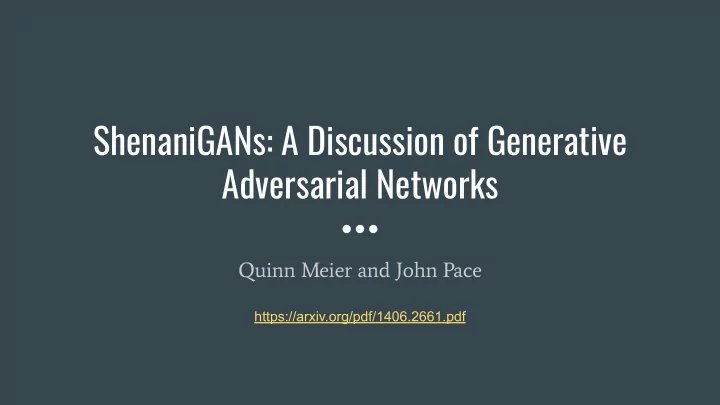

ShenaniGANs: A Discussion of Generative Adversarial Networks Quinn Meier and John Pace https://arxiv.org/pdf/1406.2661.pdf
Review of Neural Networks Feature Vector -> Feed Into First Layer -> Matrix Multiplication with Weights -> Activation Function/Dropout -> Repeat Until Output -> Backpropagate, train until satisfactory
The Motivation Deep learning does best with discriminative tasks; does less well with generative tasks Authors posit that this is due to the relative ease of using piecewise linear units in classification tasks vs. generative tasks So what if we put a discriminative task inside of the generative task?
Discussion of Related Work Other deep generative models try to provide actual probability distributions with parameters learned by training These often have ugly likelihood gradients to work with - intractable ‘Generative Machines’ don’t specify an actual probability distribution - they just try to pop out a function that recreates samples
How to Make an Adversarial Net To learn a generator’s ‘distribution’ over some data: 1) Define a prior on input noise 2) Define the generator, a map from the noise space to the data space using a differentiable function modeled by a DNN 3) Define a discriminator function modeled by a DNN that returns the probability some vector came from the actual data 4) Train discriminator to maximize correct assignments, train generator to confuse discriminator See Algorithm 1 in paper for pseudocode implementation
Figure 1 from the journal article - a visual representation of the training process Discriminator: Blue Arrows on bottom represent the function of the generator Generator: Green Data: Black
A Brief Foray Into Game Theory All that corresponds to playing a ‘minimax game’: The generator tries to minimize the maximum performance of the discriminator. The first term corresponds to the discriminator guessing correctly actual data came from the dataset, the second term corresponds to the discriminator guessing correctly that generated data came from the generator.
Some Caveats Can’t optimize discriminator to completion in the inner loop of training - will be horribly expensive and lead to overfitting May need to use alternate criterion to train generator in early stages: if discriminator is too good, generator can’t learn using second term on previous slide
Theoretical Work Not going to go into detail - involves measure theory and just a bunch of number shuffling For annotated proof, see: https://srome.github.io/An-Annotated-Proof-of-Generative-Adversarial-Networks-with-Implementation-Notes/
The Important Stufg The theoretical work section proves that: 1) The minimax game has a global minimum when the generator’s distribution is equal to the data’s distribution 2) Given enough network capacity, the ability to update the generator’s distribution to improve the minimax game’s criterion, and suitable time for the discriminator to train towards its optimum for each generator update, the generator’s distribution will converge to the data’s distribution
Overview of Experiments Given a few standard image datasets, the model was trained to create new images Test set data was compared to a Gaussian Parzen window fit to generated samples using log likelihood See paper for more generated images Image from Experiments section of article
Advantages/Disadvantages Advantages: ● Doesn’t use Markov chains - efficient Only calculates gradients using backpropagation - efficient ● No inference during learning - efficient ● Model is very flexible - just needs to be differentiable ● ● Generator doesn’t see actual data - possibly helps with generalizability Disadvantages: ● No explicit representation of the generator’s distribution over the data space Requires tuning of generator and discriminator’s dynamics - possible for generator ● to get stuck in degeneracies and lose representability
What Are GANs Being Used For? Image ‘super-resolution’ - SRGAN: https://arxiv.org/abs/1609.04802 Image taken from https://modelzoo.co/m odel/srgan For more examples, read: https://medium.com/@jonathan_hui/gan-some-cool-applications-of-gans-4c9ecca35900
What Are GANs Being Used For? Cross-domain transfer - CycleGAN: https://arxiv.org/abs/1703.10593 Image from linked CycleGAN journal article (see also: how CycleGAN ‘cheats’: https://arxiv.org/abs/1712.02950 ) For more examples, read: https://medium.com/@jonathan_hui/gan-some-cool-applications-of-gans-4c9ecca35900
What Are GANs Being Used For? Image from linked Text-to-image translation - StackGAN: https://arxiv.org/abs/1612.03242 StackGAN journal article For more examples, read: https://medium.com/@jonathan_hui/gan-some-cool-applications-of-gans-4c9ecca35900
Some fun with StyleGAN ( https://arxiv.org/pdf/1812.04948.pdf ) https://www.thispersondoesnotexist.com/ https://thesecatsdonotexist.com/ http://www.whichfaceisreal.com/index.php
Recommend
More recommend